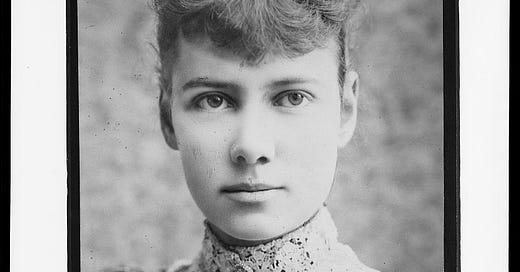In 1887, 23-year-old Elizabeth Cochrane, who would become known to the world as Nellie Bly, was an aspiring journalist looking for her next assignment. She had just moved to New York and began pitching ideas to publications there.
One publication, The New York World, responded to Nellie, asking her to proceed with one of her ideas. The plan was for Nellie to fake insanity and get admitted to Blackwell's Island Insane Asylum to conduct first-hand research. "Write up things as you find them, good or bad," her editor requested. "Give praise or blame as you think best, and the truth all the time."
Nellie wasted no time. After checking into a women's boarding house, she began her performance. Speaking incoherently and wide-eyed, she convinced those around her she was mentally unwell. Arrest followed, and soon, she found herself at Blackwell's Island. For ten harrowing days, Nellie endured the asylum's horrors until the editors got her released.
Speaking of her experience, Nellie said,
"What, excepting torture, would produce insanity quicker than this treatment?…I would like the expert physicians who are condemning me for my action, which has proven their ability, to take a perfectly sane and healthy woman, shut her up and make her sit from 6 a.m. until 8 p.m. on straight-back benches, do not allow her to talk or move during these hours, give her no reading and let her know nothing of the world or its doings, give her bad food and harsh treatment, and see how long it will take to make her insane. Two months would make her a mental and physical wreck."
Nellie published Ten Days in a Mad-House about her experience, which would help drive more funding and change in New York City's insane asylums.
About a year later, based on the book Around the World in Eighty Days by Jules Verne, Nellie became famous for attempting to travel the world in less than eighty days. Going by steamship, train, and any means available, she raced against time and expectations. Seventy-two days later, she completed the journey. Covered extensively in The New York World, her trip captivated the public's imagination and made her a national celebrity.
Nellie continued to write and report on social issues until her death from pneumonia on January 27, 1922, at the age of 57.
Sources:
Bly, Nellie. “Ten Days in a Mad-House.” Published by Ian L. Munro, 1887.
Ehrlich, Elizabeth. Nellie Bly. United States, Chelsea House Publishers, 1989.
“Nellie Bly.” Wikipedia, Wikimedia Foundation, https://en.wikipedia.org/wiki/Nellie_Bly
Nellie Bly. Photograph. Retrieved from the Library of Congress, <www.loc.gov/item/2002697740/>.













Share this post